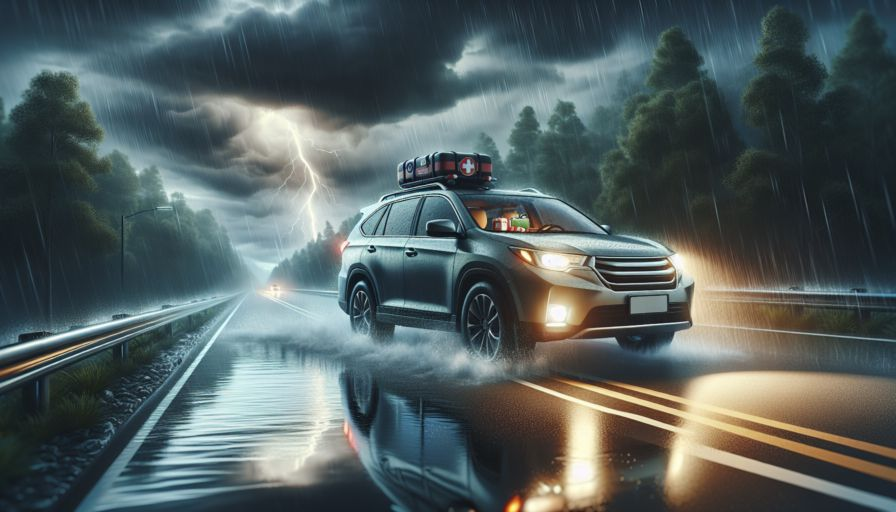When the sky changes tone and the air gets heavier, roads stop being roads. They become puzzles — twisting, splintering, sometimes disappearing. Whether you're escaping floodwaters or skirting around a wildfire’s edge, driving during a natural disaster demands a very specific kind of awareness. Not just of your vehicle, but of timing, terrain, and tension. It’s not just about getting out, it's about not making things worse in the process.
Avoid Flood Hazards Before They Drown You
There’s a reason meteorologists shout, “Turn around, don’t drown.” Floodwaters deceive. That lazy-looking current across the road could be a collapsed bridge underneath. Even six inches of moving water can lift a car and send it drifting into deeper trouble. It’s not dramatic to say your safest option is to avoid flooded roads entirely. That means planning detours, checking elevation on route maps, and understanding that your urgency doesn’t change physics. Park somewhere elevated and wait. Live to reroute again.
Stay Sharp While Driving Near Wildfires
Smoke doesn’t play fair. It seeps, it blinds, and it burns your sinuses without warning. When you’re driving through wildfire zones, it's not just the flames, it’s the air itself. Protect your visibility and your lungs by locking out external air. Every vent and window should be closed tightly, and your AC should be set to keep windows and vents sealed. Recirculating cabin air helps you breathe easier, literally and mentally, while reducing the intake of particulates and panic.
Plot Your Evacuation Like a Chess Game
If you wait until the gridlock hits to open your maps app, you’re already too late. Good disaster driving is mostly good pre-driving. That means knowing more than one way out of your neighborhood, your town, or even your county. It means rehearsing those routes with your family and printing them, just in case cell towers fall silent. Always map alternate evacuation routes that bypass likely bottlenecks, flooded bridges, or fire-prone tree lines. Bonus: If you already know where to go, your brain stays one step calmer under pressure.
Digitize Your Driving Documents
Natural disasters don’t just threaten roads and homes, they can destroy the essential paperwork you keep in your glove box. Digitizing your car insurance, registration, license, and roadside assistance info ensures you’ll have backup access when physical copies are lost, soaked, or inaccessible. Saving these files as PDFs preserves layout fidelity and makes them instantly shareable. A PDF maker allows you to convert any document into a stable, easily accessible file format; perfect for phones, cloud storage, or printouts before you roll out.
Tire Pressure Isn’t Optional During Storms
When temperatures drop or spike during disasters, your tires feel it before you do. Sudden shifts in air pressure can underinflate or overinflate your tires in hours, not days. And in slick, uncertain conditions, a misbehaving tire can cost you traction or control. That’s why you must consistently check tire PSI during temperature shifts before setting out, even if it feels tedious. Keep a tire gauge in your console and learn what your baseline looks like. Disaster roads aren’t forgiving, and tires don’t self-correct.
Navigating Through Rain and Blinding Fog
Rain changes more than visibility, it changes the way people behave behind the wheel. Brakes become hesitant, reactions slow down, and hazards hide in reflections. You don’t need to see everything to drive safely, but you do need to be seen. That’s where your headlights come in, but only the right ones. Always use low-beam headlights in rain and fog, because high beams scatter off moisture and reduce visibility even further. Be visible, but not blinding. Precision over power.
An Emergency Kit Is Essential
The day you need your emergency kit is not the day to realize you never made one. Every vehicle should carry the basics: water, snacks, a flashlight, blankets, extra chargers, and reflective triangles. But your kit should also match your climate. Wildfire zone? Add an N95 mask. Flood zone? Toss in waterproof bags. Hurricane corridor? Keep extra clothes and backup maps. The goal isn’t to ride out a week, it’s to bridge a few dangerous hours. Be ready to pack a basic roadside kit that buys you time, calm, and optionality when everything else is in flux.
Safe driving in disasters isn’t about fear. It’s about stewardship. Your decisions behind the wheel ripple out: to your passengers, the people in the next car, the responders you may never meet. Whether you're outrunning floodwaters or crawling through thick smoke, each mile you cover should be deliberate, informed, and calm. Know your routes. Secure your documents. Check your tires. And keep your toolkit as close as your brake pedal. When you drive with clarity in the chaos, you don’t just survive, you help shape the safety net for everyone else on the road.
Discover unbeatable deals on top-quality auto parts and accessories at AFA Motors — your one-stop shop for everything from brake pads to spark plugs, with free shipping on all orders!

